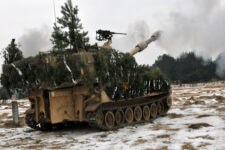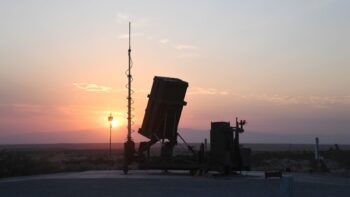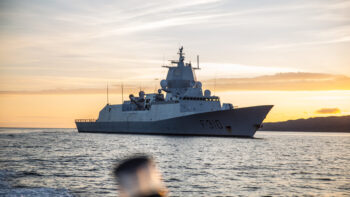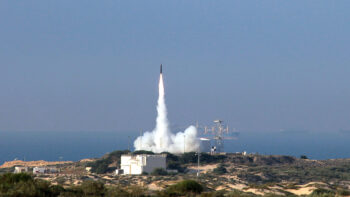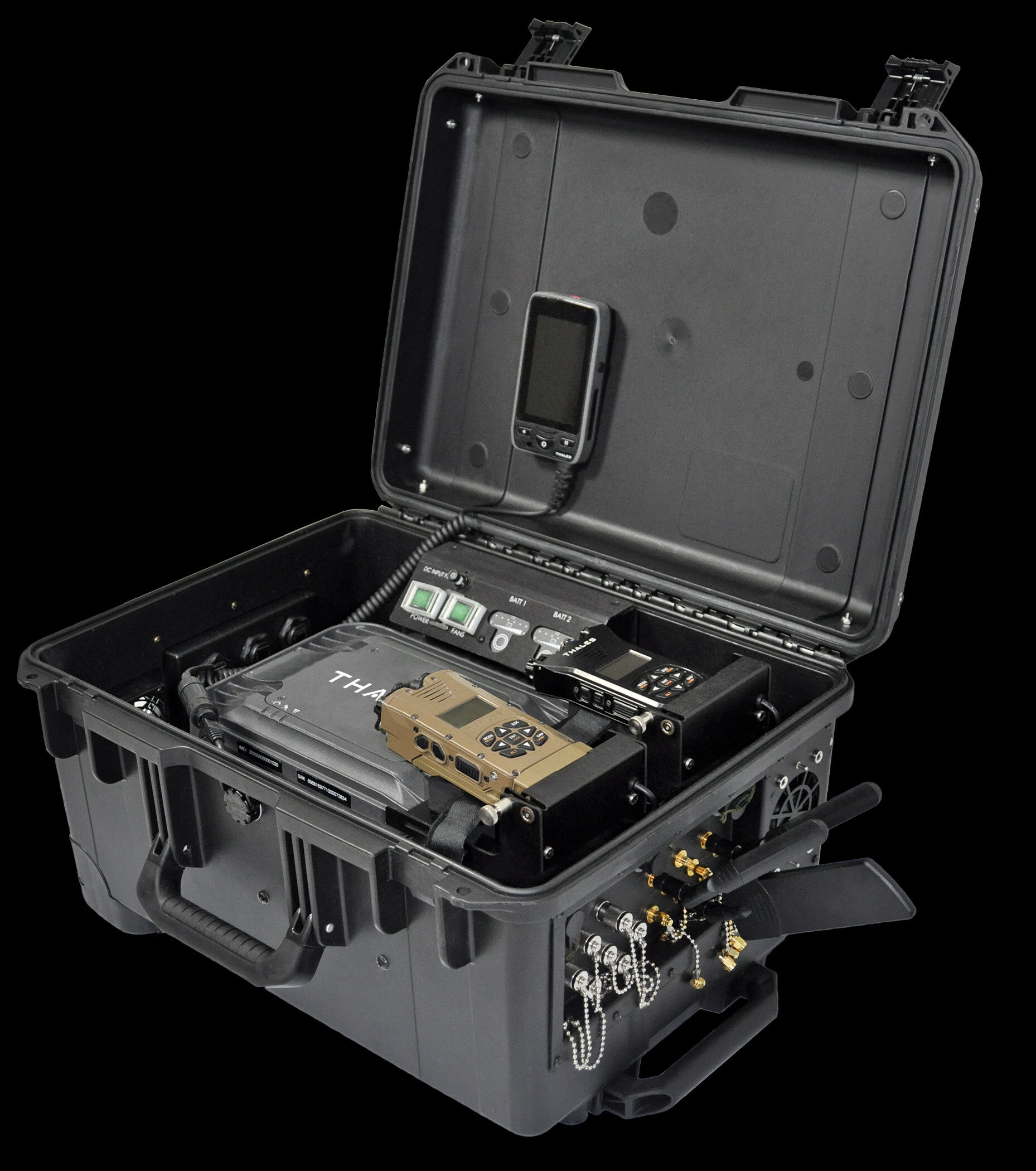
EDGE modular networked command post kits from Thales Defense & Security Inc., provide an automated gateway, cross domain solution and network management capability to facilitate PACE (Primary, Alternate, Contingency, and Emergency) communications. (Photo courtesy of Thales Defense & Security Inc.)
Higher-echelon command posts were not highly vulnerable to electronic attack or jamming during the days of asymmetric warfare in Afghanistan and Iraq. If they were connected, they could command and control.
Fast forward to Ukraine, where static non-mobile command posts emitting large signatures have proved deadly. Adversaries possess sophisticated electronic warfare capabilities that can jam communications and also deploy long-range drones to attack higher-echelon command posts. Multiple communication pathways that are easy to use while also offering mobile connectivity are a requirement for today’s military operations.
U.S. services understand command posts must be mobile within minutes and require reduced electronic signatures but also be easy for soldiers and marines to establish connectivity and network management quickly to meet operational commander needs. Mobile connectivity is an essential across all combatant commands.
This adversarial battlespace applies to both Europe and the Indo-Pacific. That means the command post of today is evolving into the mobile command post of tomorrow by shedding most of the extraneous infrastructure while maintaining much the same capability, with agility and portability, including SATCOM on the move. Modular command post kits that provide agnostic communications options, can bridge networks and offer ability to connect to commercial and military SATCOM will prove value in today’s operational environment.
“The U.S. Army’s vision is to have mobile, on-the-move command posts with a wide range of not only voice and data transport capabilities, but a mix of resilient waveforms and architectures that the units and commanders can use to collaborate across those previously static command posts,” said Gary Kidwell, vice president for Communications Systems at Thales Defense & Security, Inc. (TDSI), a major provider of tactical software-defined radios to the Army such as the Combat Net Radio, a cryptographically modernized radio drop-in replacement for SINCGARS radios that is now in low-rate production.
The description of what a next-generation mobile command post can be already exists today in the form of two EDGE modular networked command post kits from TDSI. EDGE kits provide an automated gateway, cross domain solution and network management capability to facilitate PACE (Primary, Alternate, Contingency, and Emergency) communications. EDGE, consisting of a lite-weight man-portable version and a more robust kit for mobile or at-the-quick-halt command posts, can cross band all military and some commercial radios and also provide plug and play baseband for a variety of SATCOM terminals, including emerging commercial low-Earth orbit options.
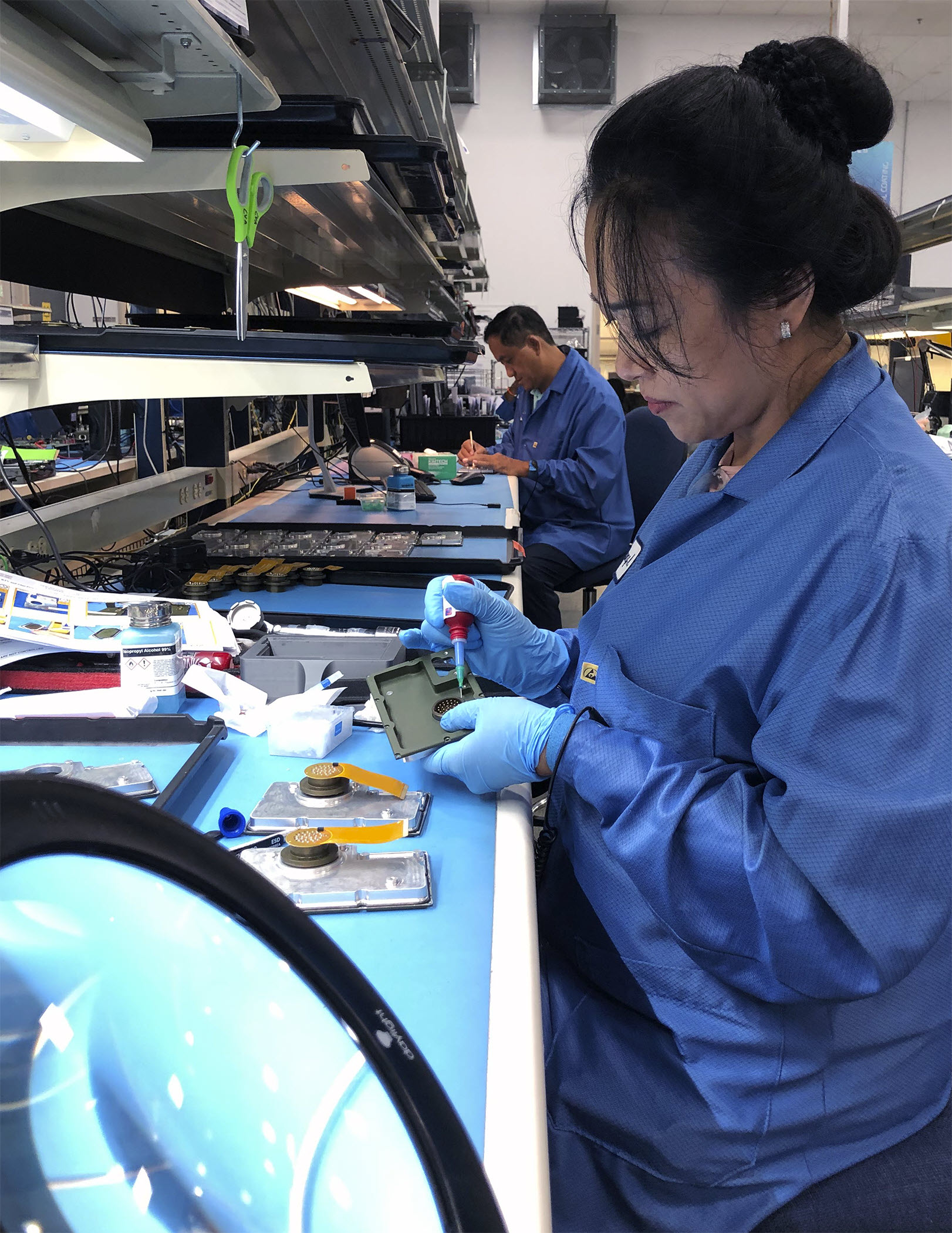
Thales Defense & Security Inc. is a major provider of tactical software-defined radios to the Army such as the Combat Net Radio, a cryptographically modernized radio drop-in replacement for SINCGARS radios that is now in low-rate production. (Photo of CNR manufacturing courtesy of TDSI)
With path diversity, the value of EDGE is clear in today’s heavy EW contested European battlespace. It has equal applicability to the U.S. INDOPACOM area-of-operations not only in terms of mobility but also in providing expeditionary, redundant communications. That means smaller, easily transportable kit well suited to island hopping operations from units like the 25th Infantry Division in Hawaii – one of the Amy’s transformation-in-contact units that is experimenting with a mix of expeditionary communication needs for the region.
EDGE is mobile across all vehicle platforms and/or hard site installations, accepts a broad range of AC/DC voltage, and is operational autonomously for 6–12 hours with two installed BB-2590 batteries. Trials and demonstrations with operational units of Thales mobility and expeditionary solutions point to universal flexibility and the ability to quickly move EDGE systems from, say, a Joint Light Tactical Vehicle or a Cold Weather All-Terrain Vehicle to a Stryker – making most vehicles and any structure a potential command post.
“We heard leadership from the 25th Infantry Division comment at the Army’s Technical Exchange in Philadelphia recently that when operating in the Pacific they could at one moment be in a military vehicle, then in a commercial vehicle, or in a subway or a hotel,” said Kidwell. “Their command post will be anywhere it needs to be depending on the phase of the operation. This gives them a degree of universal flexibility and the ability to rapidly deploy the command post kit, and take it from vehicle to vehicle or command post to command post as necessary.”
Communication Pathways
In addition to modular command post kits, formations also require resilient communication pathways to allow commanders and network operators to choose the best connectivity available within their operational environment. With the proliferation of commercial medium- and low-Earth orbit constellations, modern SATCOM terminals must be able to deliver on-the-move connections for available network transport options.
TDSI’s Tampa Microwave, headquartered in Clearwater, FL, is a leading provider of both parabolic and state-of-the-art Electronically Steered Array (ESA) technology. ESA terminals achieve switching speeds on the order of hundreds of milliseconds, and warfighters have multiple satellite communication options to include LEO and MEO, as well as military Wideband Global SATCOM (WGS) for multi-orbit/path diversity.
For the last several years, Tampa Microwave has been a leading provider of an expeditionary family of parabolic terminals to Special Operations forces and the Army’s Integrated Tactical Network program. Today, Tampa Microwave is bringing to market ESA flat panel terminal technology capable of being integrated onto a variety of military vehicle platforms.
“ESA SATCOM terminal solutions give the user massive flexibility to be able to leverage commercial military, LEO, MEO, GEO, and even HEO, a highly elliptical orbit,” said Aaron Brosnan, president of Tampa Microwave. “Terminals even include line-of-sight communication links to provide more flexibility, and do it in a way where it’s intuitive and simple to set up, operate, and manage. That’s all done in the background through the automation within the terminal design itself, including diagnostics to ensure it’s communicating properly.
“Terminal technology also has to be small and light. When you’re operating in the Indo-Pacific and jumping from island to island, you can’t do that with a 100-pound terminal,” said Brosnan. “It’s got to be small, light, and possibly even jumpable where you can come in on a parachute and set it up quickly. It’s software defined, which is where everything’s going because that’s the way you get the most flexibility.”
To offer a “communications package,” EDGE can work in conjunction with the ESA SATCOM terminals, and (but not limited to) the Thales software-defined data radio family to provide both SATCOM and terrestrial radio based network communications diversity.
“With SATCOM terrestrial path diversity, you have lots of bands available to you; one gets jammed, you’re able to flex over to another in a different part of the spectrum,” said Brosnan. “The same applies now with celestial path diversity. If I’m on a GEO that’s taken out, I can flex quickly to something in LEO at a different frequency band.
“Even in LEO, if I lose one satellite, I’ve got 3, 5, or 10 more available to me that I can hop to in a matter of a hundred milliseconds without interrupting any of the traffic flows. It’s a multi-layered approach and certainly being addressed by Space Force with Protected Tactical Waveform and Protected Tactical Satellite Communications in a multi-path architecture.”
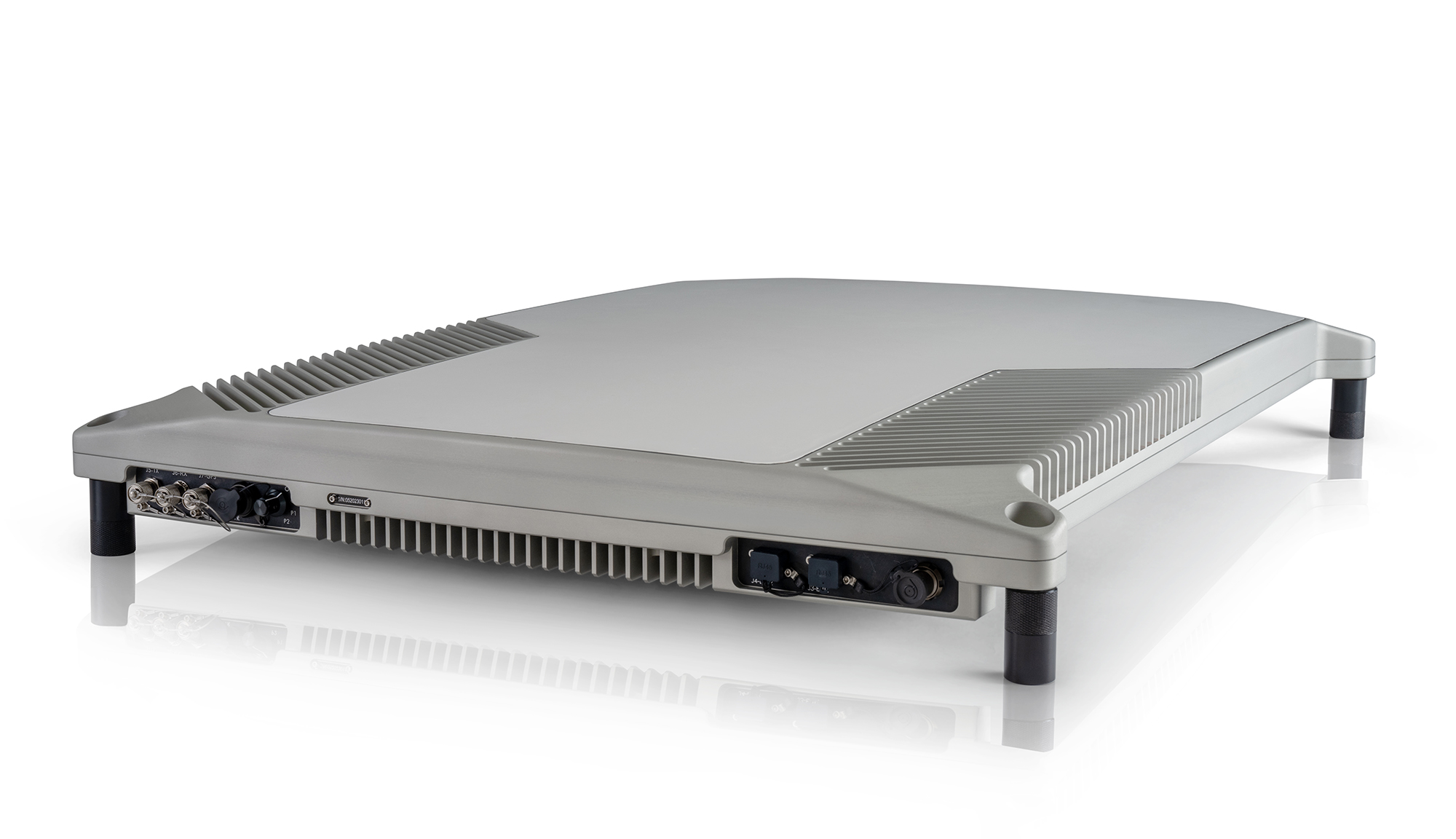
Electronically Steered Array (ESA) flat-panel technology achieves switching speeds on the order of hundreds of milliseconds, and warfighters have multiple satellite communication options to include LEO and MEO, as well as military Wideband Global SATCOM for multi-orbit/path diversity. (Tampa Microwave photo)
Multi-path diversity and agnostic approach
To offer commanders with connectivity options, TDSI has designed systems to be vendor agnostic, meaning the EDGE kits and SATCOM terminals can universally support multi-vendor network transport options such as software defined data radios, commercial and military satellite constellations, and diverse mission command applications. Regardless of vendor or radio type, EDGE can plug in data and sensor interfaces, along with voice and data radio capabilities, so that users aren’t locked into one particular vendor in terms of radios or SATCOM capabilities.
EDGE lets commanders and formations pick what radio transmission types are appropriate for their operational mission.
Transport layers that can integrate with EDGE include:
- Thales’ own radios such as the Army’s two-channel Leader Radio, the single channel Javelin radio used in ITN formations and a variety of 148 series IMBITR radios used by special operations and other joint service units.
- MANET/tactical radios (AN/PRC-148 family, AN/PRC-163, MPU5 MANET, StreamCaster, and TrellisWare TW-950)
- 3G/4G/5G/LTE capable
- Iridium LEO satellite (Certus Constellation)
- Inmarsat (Slingshot)
- Geostationary satellite (KU/Ka/X band), Tampa Microwave Scout terminals, etc.
- Kymeta™ product line
- Starlink/Starshield™
- Fenix Banshee Tactical Radio (BTR)
“What we’ve done in innovation to date and continue to do, is ensure that at the edge, as the Army moves to division as a unit of action and they pull a lot network managers and field support representatives out of the battalions and the brigades, warfighters have systems at the dismount, handheld, and command post level that are simple and easy to use,” said Kidwell.
TDSI is responsible for numerous “industry first” technologies such as multiband handheld radios, SCA-certified software defined radios, networking soldier radios, two-channel handheld Leader Radio, and Iridium NEXT terminals for global mobile satellite service access. It continues that leadership with EDGE and ESA SATCOM terminal solutions for mobile and expeditionary communications that provide users at the edge the ability to plug and play voice and data capabilities with simple interfaces and troubleshooting.












